Biography of Private Clarke Henry Marvin (40662)
10th Battalion Lincolnshire Regiment
Formerly 4046 1st/4th Lincolnshire Regiment and
20070 5th Lincolnshire Regiment
Died 28th April 1917
Soldier
- Name: Clarke Henry Marvin aka Jack
- Date of birth: 1895
- Place of Birth: Morton, Lincolnshire, England
- Date of Birth Registration: January – March 1896
- Place of Birth Registration: Bourne, Lincolnshire, England
Father
- Name: Unknown
- Name: John Carter (Step Father)
- DOB: 1876
- Place of Birth: Leeds, Yorkshire, England
- Occupation: Yardman on farm
Mother
- Name: Ann Elizabeth Marvin
- DOB: 1877
- Place Of Birth: Morton, Lincolnshire, England
- Marriage: 1898 Wisbech District (John Carter)
Siblings: (Name), (DOB), (POB)
- Clarke Henry Marvin, 1895, Morton
- John Robert Carter, 1900, Tydd St Mary (Half brother)
- Ernest Leslie Carter, 1906, Tydd St Mary (Half brother)
- George Stanley Marvin Carter, 1908, Dyke (Half brother)
- Walter Charles Carter, 1909, Dyke, (Half brother)
- Horace Arthru Carter, 1912, Gedney (Half brother)
- Eric Richard Carter, 1918, Spalding area (Half brother)
Census
- 1901: Clarke is living with his parent at Hawthorpe Road, Keisby, Lincolnshire which we now believe are his grandparents and believe that he is listed as John (Jack being a name he was more commonly known as).
- 1911: Clarke is living with his parents in The Lodge, Folkingham, Lincolnshire which we now believe are his grandparents. The census gives him an age of 15 and he is listed as a day boy on farm.
- None found
- All official records for Clarke Henry, apart from his baptism, point to his parents being Robert and Ann Marvin as can be seen on the census records. His baptism in Lenton shows his mother to be Ann Elizabeth Marvin. Ann Elizabeth was however the eldest daughter of Robert and Ann Marvin and Clarke Henry was baptised in Lenton on the same day as his aunt Nellie who was only just older than him. Robert and Ann also had a son called Clarke that was still living and so to have two sons named Clarke would be highly unusual, hence we believe this is why he was more commonly known as Jack.
The evidence points to Clarke (Jack) being brought up by his Grandparents as their own child, possibly hiding the fact that their daughter had an illegitimate child, as can be seen in the census returns. - The final piece of evidence is that after his death, the military records relating to where to send his effects lists Ann Marvin as his Grandmother. If Robert and Ann were is Parents then his Grandmother’s would have been Ann Marvin (Died 1886) or Mary Kendall.
Marriage
- No marriage for Clarke has been found and because of his age we can assume that he never had the opportunity to marry.
Newspaper Mentions
- Grantham Journal Saturday 15th July 1916
SPITTLEGATE PETTY SESSIONS
Saturday
(Before Sir J. H. Thorold, Bart. (in the chair), M. G. Thorold, Esq., Sir A. Priestley, M.P., and S. L. Williamson, Esq.)
HOUGH-ON-THE-HILL. – FULL PENALTY NEXT TIME.
JOHN CARTER, labourer, Hough-on-the-Hill, was summoned for not sending his child, Ernest Leslie Carter, aged ten, regularly to School.- Dedendant didnot appear. – Mr. A. Musson, School Attendance Officer, said that Ernest Leslie Carter was on the register for Carlton Scroop School. He visited the School on June 1st, and found the child absent. After examining the register he found that from the date of admission, December 12th, 1915, until the date in question, the School had been opened 232 times, and the child had been absent on 69 occasions. There were three children concerned, all being absent an equal number of times. When he visited the house and saw Mrs. Carter, the latter stated they were waiting to be moved to Hough-on-the-Hill. Witness told her it was absurd to keep the children at home for over a week. Mrs Carter also said they did not go to School without having hot dinners every day. – The Chairman read a letter from the defendant, which stated that he had six children, and some coming over from the front.
The Chairman said defendant would have to pay the costs, and warned him that if it occurred again the full penalty would be inflicted.
- The Times Saturday 9th June 1917
ROLL OF HONOUR.
LOSSES IN THE RANKS.
LIST OF DEAD.
All are privates except where otherwise shown. The town shown against each soldier’s name is the home of his next-of-kin, except when followed by the abbreviation “Enlt.,” when it is his place of enlistment.
SECOND LIST.
KILLED.
LINCOLN R .- Marvin, 40662 C. H. (Grantham)
- Grantham Journal Saturday 16th June 1917
Pte CLARK HENRY (JACK) MARVIN, of Folkingham.
The sad news of the death of another gallant Folkingham hero has been received by his parents. The official communication briefly states that Pte Marvin was killed in action on the 20th April and that a photograph of his grave will be forwarded in due course. A message of sympathy from the Army Council is attached. Pte Jack Marvin joined the Lincolns in May 1915 and had seen much service both in Egypt and France. Once he was invalided home with wounds, etc. He was in his 22nd year and was highly respected by his comrades in the Regiment. Much sympathy is expressed by all friends for the bereaved parents, brothers and sisters in their sad loss.
- Private C. H. CARTER, of Hough-on-the-Hill
News has benn offically received by his parents that Pte. Clarke Henry Carter, son of Mr. Carter, of Hough-on-the-Hill, who is employed by Mr. Farnsworth, at the Lodge Farm, was killed in action during Easter week, his last letter being received on the 16th April. He volunteered in May, 1915, when he was horseman for Mr. W. Randal, Bradmore, Nottingham. He enlisted in the Lincolns at Grantham. His training completed, he was sent to Egypt, and then to France, in Nov. From March, 1916, to June, 1916, he was in hospital at Epsom and Kingston-on-Thames, suffering from pneumonia. Some weeks previously he had been in hospital for three days, a bullet having passed through his lower lip. Much sympathy is felt for his parents in theor bereavement.
- Lincolnshire Echo Tuesday 19th June 1917
News has been received at Folkingham that Clark Henry (Jack) Marvin has been killed in action. He joined the Lincolns in May 1915 and had seen much service in Egypt and France. Once he was invalided home with wounds, etc. He was in his 22nd year and was much liked by his comrades in the Regiment.
- Gratham Journal Saturday 23rd June 1917
Pte. C. H. CARTER, of Hough-on-the-Hill
As recorded in our last issue, Mr. Carter, of Hough-on-the-Hill, has received official notification that his son, Pte. Clarke Hy. Carter, was killed in action durng Easter week. He voluntarily enlisted in May, 1915, in the County Regiment, and went abroad in November. From March to June, 1916, he was in hospital in Epsom amd Kingston-on-Thames, suffering from pneumonia. Prior to this he had been in hospital for three days, as the result of a bullet having passed through his lower lip.
- Grantham Journal Saturday 27th April 1918
In ever-loving memory of our dear Jack, Pte C. H. Marvin, Lincolnshire Regiment, killed in action April 28th 1917.
“It’s sweet to think we’ll meet again,
When all our parting’s o’er,
That our dear boy we loved so well,
has only gone before”.
From his ever-loving
MOTHER, FATHER, SISTERS & BROTHERS (Folkingahm)
- Grantham Journal Saturday 26th April 1919
MARVIN – In ever-loving memory of our dear Jack.
Pre C. H. Marvin (10th Lincs Regiment), killed in action April 28th 1917, aged 21 years.
“Rest, calmly rest, for thou thy part de’s play
In this great war, and death thy hand did stay,
Thy work was alone, thou laidst thine armour down,
Fought the great war, and gained the eternal crown”.
From his loving MOTHER, FATHER, SISTERS and BROTHERS (Folkingham).
Military Records
- None found
Soldier’s Died In The Great War
- These records show that Private Clarke Henry Marvin, 40662, 10th Bn Lincolnshire Regiment was killed in action on 28th April 1917 in the Western European Theatre in France and Flanders.
Pension Records
- Available
Effects Left To
- Grandmother Anne
Medals
- The British Medal
The Victory Medal
The 15 Star
Memorials
- UK:
- Folkingham, Roll of Honour in St Andrew’s Church
- Hough-on-the-Hill, Roll of Honour in All Saints (Listed as George Carter)
- Commonwealth War Graves Commission:
- In memory of Private Clarke Henry Marvin,40662, 10th Bn., Lincolnshire Regiment who died on 28 April 1917
- Remembered with honour, Arras Memorial
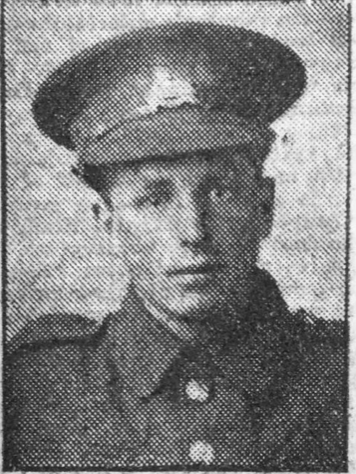
© BNA
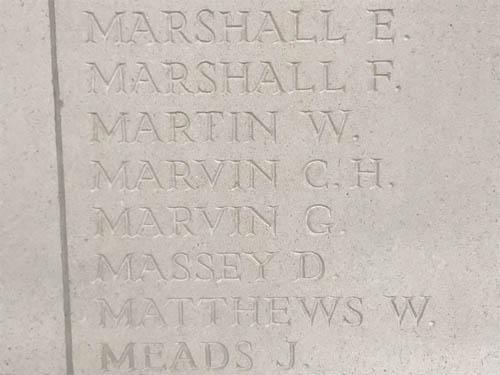
© Picture taken by South Lincolnshire War Memorials

© Picture taken by South Lincolnshire War Memorials
Military Service Timeline
-
Jack enlisted in Sleaford and later newspaper articles indicate that he had been with the regiment since May 1915.
Jack’s attestation and army record have not been found and are most likely part of the records destroyed in a warehouse fire during the WW2 blitz on London.
Remaining medal award records show that originally he was enlisted into the 4th Battalion Lincolnshire regiment (4046) then at some point posted to the 5th Lincolnshire Regiment (20070), possibly his first posting after enlistment and eventually was posted to the 10th Battalion Lincolnshire Regiment (40662).
Jack’s medal card shows that he was first posted to France on the 10th December 1915 and later newspaper articles refer to him being invalided home with wounds at one point. This period of being invalided home is most likely the cause of him being posted to a new Battalion when he was fit to serve again.
One part of the newspaper article that does not make perfect sense is that he had seen service in Egypt. The 6th Battalion and the Yeomanry were the only Lincolnshire Battalions to see active service in Egypt during the period of WW1, although regular army battalions had been pulled back from Egypt during 1914 on the outbreak of war.As we are not able to trace Jack’s exact movements during his army career, then we will have to concentrate on the final months of his service and take up the story of the 10th Battalion in 1917 from their official Battalion diary.
The 10th Battalion had been posted to France in January 1916, slightly late for this to be Jack’s first Battalion abroad, and had later seen service on the Somme. Famously the 10th Lincolnshire’s (Grimsby Chums) lead the attack on the Lochnagar Mine crater, 2 minutes after the mine explosion signalling the start of the battle of the Somme on the 1st July 1916 at La Boiselle. This action alone saw 15 of the 20 officers and 487 out of 822 other ranks become casualties.
The 10th Battalion took on reinforcements taken from many other battalions and many being third line territorial Battalions with only a few months training.
The Battalion stayed in the Somme area around Albert for the rest of the year seeing much action.By April 1917 the Battalion and by now Jack Marvin, were posted to Arras as part of the 34th Division, 101st Brigade in readiness for the upcoming battle of Arras.
—————————————-
The following transcription from the diaries includes a very detailed description of action on the 28th April, the day in which jack Marvin and other local men were killed in this action. More information regarding Jack follows after this transcription.1st April 1917 – Arras
Relieved the 15th Royal Scots in right section – relief completed without incident.
draft of 50 other ranks joined.2nd April 1917
A normal day except that our artillery was actively engaged cutting enemy wire and bombarding his rear positions. A small raid was carried out by the 11th Suffolks through our front but produced no result. a heavy fall of snow in the afternoon, trenches very muddy.3rd April 1917 –
continual activity by our artillery – Enemy retaliation very moderate chiefly directed on C.T (Communication Trenches) which were blocked in several places. The battalion at this time was holding the line from St Pancras map reference G6.a.1/2.9 sheet 51B Trench maps 1/10000 or 1/20000 scale to New St G6a3.74th April 1017 – Right of K section, North of Arras / Bailleul Road
The bombardment of enemy’s trenches in connection with “Operations against Vimy ridge began at 6am this morning. Under the scheme this was to be V day, but the attack was postponed 24 hours and notification was received during the day that the 5th inst would be V day, the day of the attack to be Z day, 9th inst – Most of men that could be spared engaged in carrying trench ladders and trench bridges into position during the night.. Owing to the deep mud the work was most exhausting.A discharge of gas shells was made from Livens gas projectors at the commencement of the bombardment. Enemy’s barrage was slow and not heavy, mostly directed against communication trenches on the high ground around Esquarissage and to North East during the afternoon. Part of the front was taken over by the 102nd Brigade, one Battalion of the 103rd Brigade coming and taking over a portion of the front line. The Divisional front was then held by three Battalions, one from each of 101st, 102nd and 103rd Brigades. The 10th Lincolns (101st Brigade) held from St Pancras, see above, to Grid line between G6a and G6c (see trench maps). This was the sector allotted to the 101st Brigade on the day of the attack.
Patrols were sent out at night under 2/LT H.P. Clewes and 2/LT Lodge and examined enemy’s wire, ascertained positions of sentry groups, the G.D.C 102nd Brigade then in command of the sector complimented the Battalion on the information brought in. at this time information about the enemy’s movements was required as it was thought that he might evacuate all of his front line without waiting for the assault. 2LT Clewes managed to crawl through the enemy’s wire and entered his front line trench at about G6.a.75.05, he found the trench to be very deep and well revelted, he saw the entrance to a dug out and a point where the trench was blown in with a track over debris showing that patrols passed at intervals. He saw a sentry on the right using his rifle and firing a very light. Both patrols found enemy wire much damaged and blown up on to his parapet in many places. The enemy had many sentries posted and they were alert.5th April 1917 – In Trenches as above
W day of bombardment which continued. Enemy’s front lines and his wire could be seen to be badly damaged. Enemy’s retaliation was lighter than on previous day. The casualties during this tour would have been very light except for an unlucky shell which dropped into two parties of men which had met in a trench. This one shell put out of action 10 men of this Battalion and 12 of another. Otherwise the casualties would have only numbered 4 or 5. One company headquarters was blown in wounding a runner who afterwards dies. Captain Worthington and Lt Mattison who were in the dugout unhurt. 2/LT McArthur was burried by a shell and could not be found, when a second shell burst knocking over Captain Dent and 2nd LT Johnson and uncovering Lt McArthur’s helmet. He was dug out, he was shaken and unhurt as were the other officers.6th April 1917 – Louez
The Battalion was relieved in the evening by the 16th Royal Scots. Relief commenced at 6 pm complete soon after midnight. Battalion moved to Louez into tents, headquarters and officers in a small chateau. Men were all in by 5am – the weather had been bad during the tour and the men were very dirty and weary, many had stood in water for days and there were many cases of sore feet.7th April 1917 – Louez
Battalion cleaning and resting but a working party of 100 men had to be furnished the night of 6th/7th – 2/LT Roebuck E de L.W. joined.8th April 1917 – Louez
The Battalion continued cleaning up , overhauling arms and equipment and preparing to move forward to take part with the 101st Brigade in operations. During the day stores, bombs, flares, wire-cutters, tools etc were distributed to the men and distinguishing marks issued in the form of a yellow triangle (12 inches) to be worm on the back , carried by the whole division, and small red and yellow flags on sticks issued two per section.9th April 1917 – 14th April 1917 – Battle of Arras – Pont Du Jour
Battalion took part on the 9th in an attack against the “Pont du Jour” southern end of Vimy Ridge. A report on the operation was added to their diary but due to the length tis has not been fully transcribed. This has been posted as a series of pictures attached to this post. As this report details Jack’s battalion movements but does not relate to his final action it has not been transcribed here for fear of boring the reader but can be seen in the attached photographs.
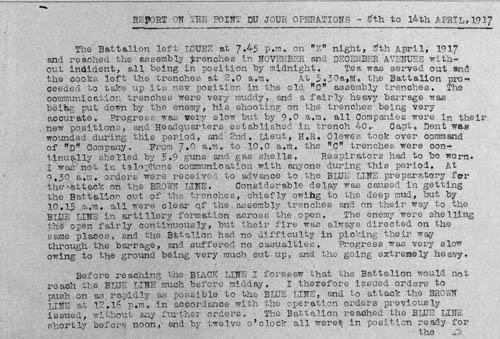
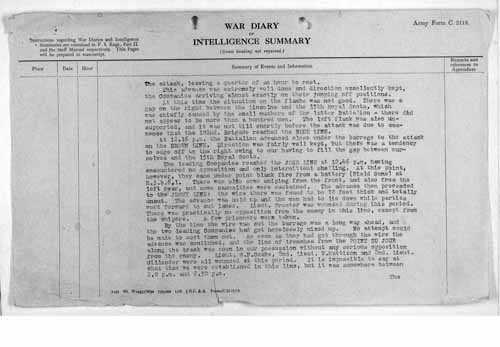
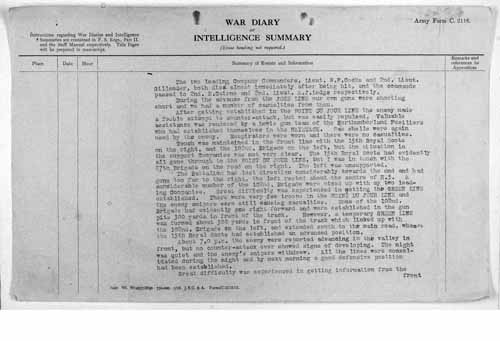
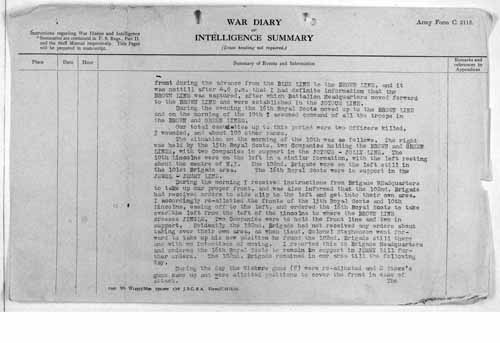
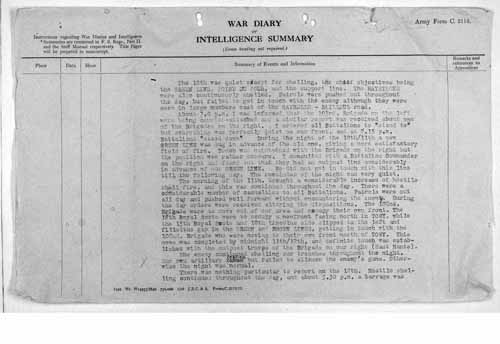
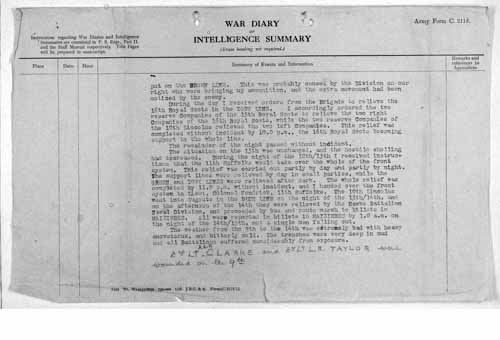
Taken from 10th Battalion Diaries, T.N.A.
-
15th April 1917 – Maiziers
Battalion Resting , cleaning up and refitting. Men quite exhausted and all equipment and clothing in a very bad state.
The casualties during the operation 8th to 14th amounted to 2 officers killed, 5 officers wounded, 150 other ranks killed wounded or missing and about 60 other ranks sent to hospital owing to exposure and exhaustion.16th April 1917 –
Lt Abbott, 2/LT Cowen and a draft of 69 other ranks joined19th April 1917
Inspection by G.O.C 34th Division.20th April 1917
Lt Colonel G W B Clark, O.C. admitted to hospital sick, command assumed in his absence by Major W A Vignoles.
Draft arrived 1 officer and other ranks (2/LT F H Lucking)21st April 1917
Battalion proceeded by route march to billets in Larassett.
Draft arrived 95 other ranks.22nd April 1917
Battalion proceeded to Y Huts (Map ref L.1.b.9.1 sheet 51c N.E.)
Captain W E Knight and 2/LT H W Bannister joined Battalion.23rd April 1917-
6am – Battalion proceeded to Arras with 20 officers, remainder of officers and 108 drtails proceeded to Chapelle Fermont, Captain Rennington in command.
On reaching Arras orders were received that the Battalion was to be ready to move at short notice to line.
5.45pm – Moved to a position in reserve on the Pont Du Jour occupying the Lusty-Lumpy-Locust trenches in H.9 (Sheet 51G)
All in by 9pm24th April 1917 –
The enemy shelled the Pont du Jour Road and the trenches throughout the day with 150mm shells, causing casualties, 4 other ranks killed, 9 other ranks wounded. During the night 23rd/24th he shelled the area almost continuously with gas shells. 2/LT Cowen was admitted to hospital gassed and 2 other ranks gassed. Enemy made a counter attack during the day near Gavrelle and during this period shelled the Pont du Jour and forward slope very heavily.
8pm to 5am – Battalion moved to railway Cutting in square H23 sheet 51B, the brigade having relieved a brigade of the 51st division. Battalion in support to 16th Royal Scots and 11th Suffolks, who moved into front line facing Chemical Works-Cemetery-Roeux in squares I13 and 19south of the railway. In position by 5am 25th.25th April 1917
Night of 25th/26th furnished a working party of 200 men under 4 officers, 2/LT Lavender found 1 officer and 1 private of 4th Seaforths wounded in a part of our line near MT Pleasant Wood. They had been lying out since attack of 23rd. Casualties nil.26th April 1917
9.30pm – Relieved 11th Suffolks taking over part of the line from Railway 600 yards along Ceylon Trench. 15th Royal Scots taking over night. 103rd Brigade on North of the railway. Exact situation North of Railway obscure but 103rd believed to holding Calabar.27th April 1917 –
2AM – 2/LT A B Crouch killed while in charge of working party digging CAP and Care trenches. Three prisoners taken by a sentry Group, they appeared to be deserters.2.30am – Enemy fired about 20 light Trench Mortar bombs (Pineapple) from direction of Cemetery
4pm – Chemical works bombarded by our heavies
6pm – Disposition of the battle, 2 companies in Ceylon, two on Road through H2.4.6 with Battalion Headquarters.
Strength – 18 officers/ including M.O. Attached) and 626 other ranks.Orders were issued during the day for the Battalion to take part on the morning of 28th in a general attack on the enemy’s lines. The 34th Division being outside the Arras – Biache St Vaast railway with 37t Division on the left and 12th Division on the right. The object of the 101st Brigade a line from the Scarpe river East of Roeux through I.20.a to track at I.14.C.5.0 thence along the track through I.14.c and I.14.A to railway. Order of Battle, 15th Royal Scotts on right, 10th Lincolns, – 11th Suffolks, left. 16th R.S. attached to other battalions as moppers up, 2 COs to 15th R.S. – 1 company to each of Lincoln’s and Suffolk, copy of 10th Lincolns operation order and a map are attached. Zero Modified to be 4.25am on 28th.
28th April 1917 –
1AM – 11th Suffolks commenced moving into front line and taking over Celyon from Corona (Exclusive) to Railway. Lincolns front two companies D and C moved into Care and Cap, B and A companies into Ceylon from Colne to Corona and trench from Cap to Corona North of Mount Pleasant Wood. All companies in position. 15th Royal Scots moved south and were not in touch with Lincolns. 20th Northumberland Fusiliers were in Brigade Reserve, and were formed up in “Funk” holes along the road through H24.d and H24b. Write orders to garrison front line after zero as soon as the barrage (Enemy’s) allowed. The headquarters of the four Battalions of the Brigade (Police cooks etc) were also along this road with the advanced Brigade Report Centre at H24.d.81/2.91/2 – Tea and rum was served to the men about 3am.
4.15am – As the assembly trenches didi not face the direction of advance the troops began to get out at 6.15 and form up in the open, the trenches were very congested and there was a certain amount of noise and probably the enemy heard it as about this time he commenced firing Trench Mortars, 77mm shells and bursts of machine gun fire. The morning was dark and it was very difficult for men to determine direction of advance.
Zero – The companies appeared to start well, but were very soon met by intense machine gun fire and casualties were very numerous, a large number of dead were seen on the ground later on . The machine gun fire came mainly from Chateau enfilading our front, also from a house along the road to Chemical Works, while Clip Trench was strongly manned and the houses around Cemetery full of enemy.
5.15am – The situation at this time, which was not known until later, appears to have been as shown on map, this being the furthest point reached in the attack. See letters and dotted line in ink on map
A – 20 yards from Clip, Captain Newton established himself with about a dozen men, the enemy had a block in Corona trench here and three men were killed trying to pass it. a machine gun was firing from house.
B – A number of men in shell holes
C – Other men in shell holes and a lewis gun in action under Lance Corporal Riggall
D – Further men in shell holes, but touch was not obtained with these
E – Captain Worthington and about 20 men in a half dug trench endeavouring to consolidate, a runner from him arrived about 7.30am5.30am – The enemy came out of his trenches and from houses in strength and began to surround the men in the shell holes at B and some endeavoured to get back, but were mostly shot down, while about 30 nearly all wounded were seen to surrender.
Touch was established with Ceylon to Captain Newton by Lt Dickson whoo was in Corona with an abandoned signal station. The Officer Commanding came up and visited Corona
to ascertain situation.5-30 to 6am – (Note times are all approximate as were not noted at the time) O.C. then collected all the men he could find and directed then to the junction of Corona and Ceylon to join 2/LT Dawson who had some men here. Lewis Guns were directed up the trench and sent forward to Captain Newton also a stokes gun which was eventually got into action near this junction. With the guns sent to him Captain Newton did considerable execution on the enemy holding the houses north of Cemetery. Several guns were put out of action and the gunners killed and as by this time he was unsupported on right on left, he withdrew his men to Ceylon and touch was established with Suffolks on left, who once more had some men in the front trench. The Lincolns manned Ceylon from Corona inclusive to the South West there were no other troops in Ceylon and touch had not been obtained with the 20th Northumberland Fusiliers who about this time were moving into Cusp, South of Mt Pleasant Wood.
A Report came in shortly afterwards that Captain Worthington had had to withdraw his small party now reduced to about 10 into Care.
8am (about) – Men were seen to be coming back from East of the Wood and soon afterwards the enemy’s infantry appeared from dead ground near Roeux to counter attack. A wounded officer who was lying out and who afterwards got in, said they came out of Roeux and covered by heavy machine gun fire from chateau and artillery on Mt Pleasant Wood which seems to have been the objective of the attack. Captain Worthington was killed by a shell in Care or Cap, and his men very few now left retired; the party in Ceylon showed signs of unsteadiness, but the officers and NCOs kept them in hand and they fought well holding their trench throughout.
Lance Corporal Riggall states that he kept his gun in action at the point C against the counter attack until the enemy were close to him and his gun out of action, when he managed to get back to our lines, though the two or three men with him all became casualties.
As the attack developed, it was met by lewis gun and rifle fire from the 20th Northumberland Fusiliers in cusp and Lincolns in Ceylon. This fire broke up each flank of the attack but 200 or more men reached our lines and entered Care, Mt Pleasant Wood, Colne (a partially dug trench not connected to Ceylon) and a number 30 or more, reached Ceylon near Colne, and fired on men moving behind.
The 20th Northumberland Fusiliers organised bombing parties up Ceylon and Cusp towards the Wood, and Lincolns down Ceylon to meet the Northumberlands. This party killed the NCO in charge of the enemy’s party and teh remainder ran back from Ceylon to Wood. As the bombing parties closed on the wood the enemy began to run back, and as they retired heavy fire from Lewis guns and rifles was brought to bear on them by the Lincolns and Northumberland Fusiliers in Cusp causing many casualties. A bombing post in charge of Sgt MacCrae, 16th Royal Scots attached to Lincolns held the trench to north of wood throughout the counter attack. About a dozen of the enemy in and around the wood eventually surrendered and the situation was cleared up by 12.30pm
12.30pm – Touch was established with reserve line and the Lincoln garrison in Ceylon strengthened by collecting and sending forward all Lincolns that could be found. In this way the number was increased to 70 and eventually after dark to 100.
In connection with the operations of April 28th 1917 the following recommendation for immediate reward were made :-
Captain David Harris Jones RAMC attached 10th Lincs – For – Near Reoux on April 28th 1917 and subsequent days this officer showed the greatest devotion to duty, taking out search parties each night which thoroughly examines No Mans Land for a distance of 100 to 150 yards from our line. His action caused a number of men to be rescued, some that had lain out for 4,6 and 7 days and nights being brought in, His hard work and devotion was the means of saving a number of lives
Captain Robert White Newton – Near Reoux on April 28th 1917, after the battalion had been held up by machine gun fire in which heavy casualties were sustained, this officer quickly reorganised small parties of men from various companies and met the enemy’s counter attack inflicting loss on him. By his courage and determination he kept his men together when the enemy had obtained a footing in our trenches and organised a bombing party which helped to clear the enemy out. He showed great coolness throughout at a critical time.
40938 Lance Corporal Michael Devaney Morrison – Near Reoux on April 28th for carrying out valuable patrol work when enemy was in our trenches; for work in covering stretcher bearer parties searching No Mans Land, he volunteered for any arduous work that was required.
1798 Lance Corporal James Williams – Near Reoux on April 28th 1917 when under very heavy and accurate machine Gun fire which had previously put out of action three Lewis guns and several gunners, he brought his Lewis gun into action against an enemy counter attack and caused the enemy heavy casualties.
468 Private John Cyril Horace Crisp (Stretcher Bearer) Near Reoux on April 28th 1917, He followed his company into action carrying a bag of shell dressings to within 30 yards of the enemy’s trenches. He moved about under heavy machine gun fire and dressed about forty wounded. He remained until enemy showed signs of coming out when he returned using his last dressings on the way.
1340 private Eric Platt (stretcher bearer) Near Reoux on April 28th 1917 he went out in daylight in full view of the enemy to a badly wounded man and getting him on his back brought him safely to the trenches. He was out every night with parties searching for wounded in No Mans land.
The casualties as far as known at the time of writing were
D Company.
Lt H P Hendin – missing believed killed
2/LT T E Lavender – missing
2/LT W E Robinson – wounded
2/LT E de L Roebuck – Missing
B Company
Captain F Worthington – Killed
Lt W I Abbott – Wounded
C Company
2/LT V Irvine Taylor – Killed
2/LT D A Gough – Wounded
2/LT F H Lucking – Missing
A Company
2/LT J S Hill – Missing
2/LT H Elsom – Missing
2/LT H J Lodge – Missing
Battalion Headquarters
LT E D Dickson – MissingOther ranks killed, wounded and missing estimated at 420 of that about 200 are known to have been evacuated wounded and 40 identified as killed.
The remainder of day passed quietly except for bursts of shelling on reserve line. Lincolns retained their position in Ceylon trench; a party of 16th Royal Scots garrisoning the South West end of the trench. 20th Northumberland Fusiliers in Care and Cap.
29th -30th April 1917
Passed quietly except for intermittent shelling
8.30pm Battalion relieved by the Household Battalion, 10th Infantry Brigade, 4th Division – Battalion moved out via tow path along river Scarpe to bivouac near St Nicholas.Each night serach parties were organised by the Medical Officer Captain D Harris Jones, RAMC, attached to 10th Lincolns to search for wounded. These explored No Mans Land up to 100 to 150 yards from our front line and all ground behind. They found a number of wounded including casualties belonging to 51st Division wounded on the 23rd who had been lying out 6 and 7 days and nights; they were doing well and likely to recover. Two enemy wounded were also brought in who had been out 36 hours.
The regiment making counter attack on the 28th appears to have been the 3rd Battalion of the I.R – this battalion had marched that morning from Biaches and was thrown straight into the attack, advancing from the village of Reoux. The enemy’s troops in this section were located as follows:-
185th I.R from Frampoux-Fresnes Road in I.2 southwards to Railway.
65th R.I.R from Railway to crossroads at cemetery
65th I.R thence to River Scarpe inclusive.
Sources
- WW1 Soldier’s Records (www.ancestry.co.uk)
10th Battalion Lincolnshire Regiment War Diary (The National Archives, London)
1st Battalion Lincolnshire Regiment War Diary (The National Archives, London)
The History Of The Lincolnshire Regiment – C.R.Simpson
Commonwealth War Graves Commission - British Newspaper Archive.